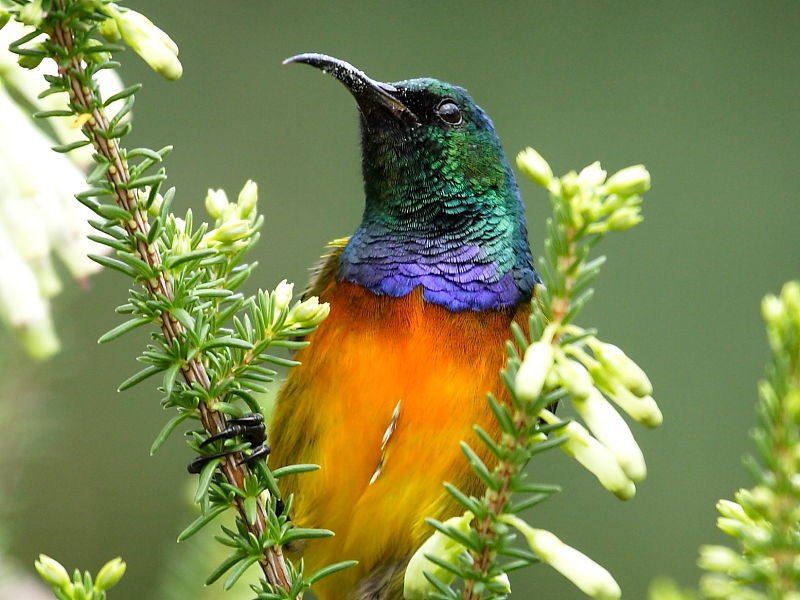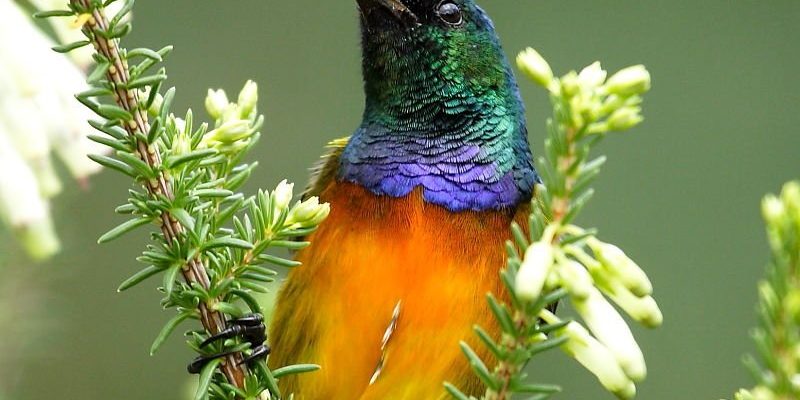
When you think of vibrant colors in nature, the Orange-Breasted Sunbird might just take the cake. Imagine a small bird, bursting with shades of orange, green, and blue, flitting through the air like a living jewel. This beauty isn’t just a feast for the eyes; it plays a vital role in its ecosystem, popping up in gardens and natural habitats across Southern Africa. You can think of them as nature’s tiny, lively pollinators, busily sipping nectar while bringing a splash of color wherever they go.
The Orange-Breasted Sunbird is part of the sunbird family and is often admired for its dazzling plumage and acrobatic flying skills. If you’re lucky enough to spot one, you might see it hovering in mid-air, much like a hummingbird, as it collects nectar from flowers. Their unique adaptations not only help them thrive in their environment but also intrigue birdwatchers and nature lovers alike. Let’s dive deeper into what makes this little bird so special.
Physical Characteristics
The Orange-Breasted Sunbird is a sight to behold. Adult males are particularly striking, displaying bright orange underparts contrasting with a glossy green back and head. Their iridescence can make it challenging to pin down the exact hue in different lighting—sometimes they seem to shimmer like emeralds in the sun! Females, on the other hand, are less flamboyant, sporting a more subdued olive color, which helps them blend into their surroundings, especially when nesting.
Size-wise, these sunbirds are small but not to be underestimated. They typically measure about 10 to 12 centimeters in length, with a wingspan that allows for agile flights. Their long, slender bills are perfectly designed for sipping nectar from tubular flowers, making them adept pollinators. This specialization not only aids their survival but also supports the plant life around them, completing a vibrant cycle of life.
Habitat and Distribution
You might be curious where to find the Orange-Breasted Sunbird. These birds primarily inhabit the fynbos ecosystem of South Africa, particularly in the Western Cape region, as well as parts of Namibia and Botswana. The fynbos is a unique and diverse floral kingdom, characterized by its Mediterranean climate and rich biodiversity. This eco-region plays host to a variety of flowering plants, which are crucial for the sunbirds’ diet.
As a general rule, the Orange-Breasted Sunbird loves areas where flowers abound—think of gardens, shrublands, and even urban parks. They can often be spotted darting from bloom to bloom, ensuring their colorful presence adds cheer to the landscape. As they swoop between flowers, you might even notice their distinctive call, which is a delightful mix of chirps and whistles, further enhancing the enchanting atmosphere of their habitat.
Diet and Feeding Habits
The Orange-Breasted Sunbird is primarily a nectar eater, which is why it’s often found visiting flowers. Their long bills allow them to reach deep into blossoms, sipping the sweet nectar with delightful agility. However, these birds are not picky eaters. Along with nectar, they also consume insects and spiders, especially during breeding season when they need extra protein to raise their young. This blend of diet helps maintain a balanced ecosystem, as they contribute to pollination while also keeping insect populations in check.
When it comes to feeding, sunbirds are also known for their cleverness. They can be quite territorial and may defend prime feeding areas against competitors. This behavior is not just about ensuring their own food supply; it’s also about keeping a vibrant population of flowers healthy. When they flit from flower to flower, they help spread pollen, making sure that plants reproduce and thrive, thus supporting their own food sources.
Behavior and Social Structure
Orange-Breasted Sunbirds display fascinating social behaviors. Generally, they are solitary when feeding but can be seen in small groups during migration or when conditions are favorable. Males are known for their eye-catching displays, especially during mating season, where they perform elaborate courtship rituals to attract females. These displays often include vibrant aerial routes and vocalizations that echo through the flowers.
Despite their small size, they exhibit strong personalities. Male sunbirds can be quite aggressive, especially when it comes to defending their territory against rivals. This behavior is important for their survival, ensuring access to ample food sources and better mating opportunities. Their interactions are filled with chirps and dances, creating a lively atmosphere wherever they are found.
Breeding and Nesting
Breeding time for the Orange-Breasted Sunbird typically occurs from late summer to early autumn. During this period, males engage in a colorful display to attract females, often showcasing their plumage while singing to lure their mate. Once paired up, both parents work together to build a small, cup-shaped nest in shrubs or trees, usually concealed among leaves for protection against predators.
The female usually lays around two to three eggs, which she incubates for about two weeks. After the eggs hatch, both parents take turns feeding the chicks a diet primarily composed of insects and nectar. This teamwork not only strengthens their bond but also ensures the survival of their young, who grow rapidly in the safety of their cozy nest.
Conservation Status
The current conservation status of the Orange-Breasted Sunbird is relatively stable, but they still face threats from habitat loss due to urbanization and land development. Climate change also poses risks by altering their habitats and food availability. Conservation efforts are essential to ensure that future generations can enjoy the beauty of these magnificent birds. By supporting local conservation organizations and preserving natural habitats, we can all play a part in protecting these vibrant creatures.
Interesting Facts
| Common Name: | Orange-Breasted Sunbird |
| Scientific Name: | Anthobaphes violacea |
| Size: | 10–12 cm (4–5 in) |
| Diet: | Nectar, insects, and spiders |
| Habitat: | Fynbos, gardens, and parks |
| Breeding Season: | Late summer to early autumn |
| Conservation Status: | Least Concern |
FAQ
What is the lifespan of an Orange-Breasted Sunbird?
The lifespan of the Orange-Breasted Sunbird in the wild typically ranges from 3 to 5 years. However, some individuals can live longer, especially if they are not heavily impacted by predators or harsh environmental conditions. Like many small birds, their lifespan can be influenced by several factors, including food availability and habitat quality.
Are Orange-Breasted Sunbirds migratory?
No, Orange-Breasted Sunbirds are generally non-migratory. They tend to stay within their preferred habitats year-round, unless there are significant changes in food availability or environmental conditions that force them to relocate. Their strong territorial nature helps them establish and defend their home ranges effectively.
How can I attract Orange-Breasted Sunbirds to my garden?
If you want to attract Orange-Breasted Sunbirds to your garden, consider planting native flowering plants that produce tubular blooms, as these are their primary food source. Plants like proteas, aloes, and certain fynbos species are particularly appealing to them. Providing a shallow birdbath can also help by giving them a place to drink and bathe, making your garden an inviting oasis.
Do Orange-Breasted Sunbirds have any natural predators?
Yes, like many small birds, the Orange-Breasted Sunbird faces threats from natural predators such as cats, hawks, and snakes. Nesting near dense foliage can offer some protection against these predators, as it helps conceal their nests. They rely on agility and quick flight to evade predators when foraging or moving between feeding areas.
Can I keep an Orange-Breasted Sunbird as a pet?
Keeping a Orange-Breasted Sunbird as a pet is not recommended and is often illegal in many areas due to conservation laws. These birds are highly specialized in their natural habitats and require specific diets and environments to thrive. Instead of keeping them in captivity, enjoy observing them in the wild or in your garden where they belong.
What sounds do Orange-Breasted Sunbirds make?
Orange-Breasted Sunbirds produce a variety of sounds, including chirps, whistles, and trill-like calls. Their vocalizations are often most pronounced during breeding season when males are trying to attract females. You might hear a delightful mix of melodies that fills the air with a cheerful ambiance, complementing their vibrant appearance as they fly among the flowers.
How do Orange-Breasted Sunbirds help the ecosystem?
Orange-Breasted Sunbirds play a crucial role in their ecosystems as pollinators. While feeding on nectar, they transfer pollen between flowers, aiding in their reproduction. This activity supports plant diversity and health, creating a balanced ecosystem. Additionally, by feeding on insects, they help control pest populations, demonstrating the interconnectedness of life in their habitats.
What is the best time to observe Orange-Breasted Sunbirds?
The best time to observe the Orange-Breasted Sunbird is during the early morning or late afternoon when they are most active in search of food. During these times, you’re likely to see them darting around flowers and listen to their cheerful songs echoing through the air. Visit areas with abundant flowering plants to increase your chances of spotting these lovely birds.

